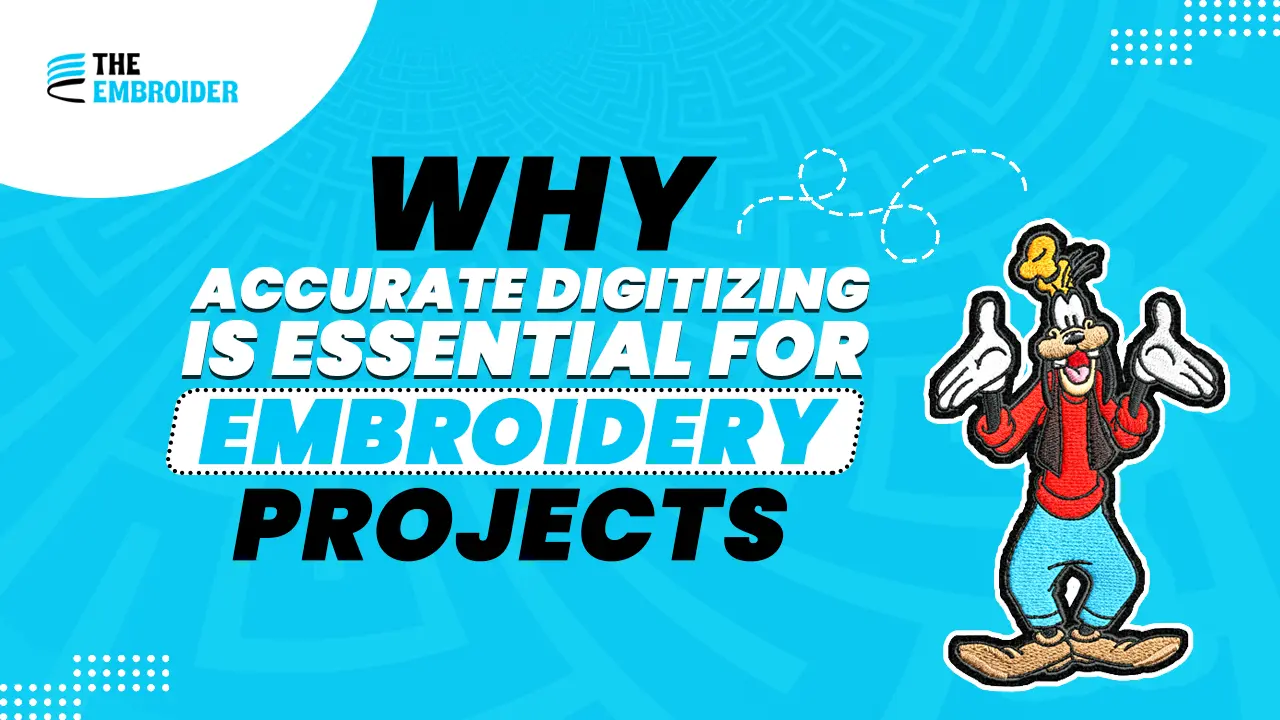Ever ordered a shirt or jacket with a logo that looked perfect in the mock-up, but after stitching it came out blurry, warped, or just off? That’s often because the digitizing was weak. Before the first thread hits your fabric, digitizing sets the tone. If you use a professional Custom Embroidery Digitizing service early, you’ll avoid mistakes that cost time and money.
Accuracy in digitizing means fewer mistakes, faster production, and less waste. When your design file is precise, the embroidery machine knows exactly where to stitch, how to pull thread, what path to take, and how to handle tricky fabrics. It’s not just nice to have, it’s essential for saving both time and money.
Key Facts That Show Why Accuracy Pays Off
- The global embroidery machine market is estimated at USD 5.90 billion in 2025, and is forecasted to reach USD 7.88 billion by 2034, growing at ~3.28% CAGR. (Source: Precedence Research)
- The embroidery software market was worth about USD 3,167.70 million in 2023, and expected to grow to around USD 8,071.96 million by 2032, with a CAGR of ~9.80%. (Source: Zion Market Research)
These numbers tell us people want more custom, better-looking embroidery. They’re willing to invest in quality, especially when accuracy reduces waste & speeds up fulfillment.
What Does “Accurate Digitizing” Really Mean?
When someone talks about accurate digitizing, here’s what they’re referring to:
- Correct Stitch Types: running, satin, fill, etc., chosen for how the fabric behaves.
- Stitch Density: not too tight (which causes puckering), not too sparse (which looks weak).
- Underlay & Stabilization: support for the fabric so the design stays stable during and after sewing.
- Clean Path & Sequence: the order stitches are made, and direction of stitches to avoid visible flaws.
If any of these are off, even a great design will look bad once stitched.
How Accurate Digitizing Saves Time & Cost: 8 Real Benefits
Here are specific ways being precise in digitizing helps your project finish faster and cost you less:
1. Less Rework & Fewer Errors
A design that’s digitized accurately means fewer misaligned threads, fewer skipped stitches. Mistakes cost time and material, accurate work means you skip those.
2. Quicker Turnarounds
When everything is prepared well (right stitch type, density, path), the machine runs smoother with fewer hiccups. That means less downtime and faster delivery to customers.
3. Material Savings
Optimized stitch paths and proper density reduce thread and fabric waste. In large orders, this savings adds up fast, businesses report around 30% less thread consumption when stitch paths are cleanly mapped and density is matched to fabric. Even small per-piece savings matter when your volume is high.
4. Consistent Quality Across Runs
Whether you’re making 10 pieces or 1,000, accurate digitizing helps ensure every item looks the same. No surprises. That consistency strengthens brand reputation.
5. Fewer Machine Problems & Downtime
Bad files cause thread breaks, jammed needles, or uneven tension issues. Those cause delays. Accurate digitizing avoids many common causes of machine trouble.
6. Lower Long-Term Cost
Yes, professional digitizing may cost a bit more up front. But when you subtract waste, returns, reworks, and damaged customer satisfaction, you come out ahead.
7. Improved Brand Perception
Well-stitched designs look sharper. Brand logos that look crisp on hats, patches, uniforms signal professionalism and attention to detail. That helps customer trust.
8. Greater Flexibility for Design Choices
When files are precise, you can try more creative techniques: 3D puff embroidery, complex appliqués, mixing textures. But without accuracy, those choices often backfire.
Choosing a Digitizing Service That REALLY Performs
To make sure you get all these benefits, pick your digitizing partner wisely. Here’s how:
- Check Their Portfolio & Reviews: Look for examples of fabric types and complex designs they’ve already done well.
- Ask for Sample Stitch-Outs: Before bulk production, test on your fabric to check tension, density, alignment.
- Check Turnaround & Revision Policies: Good services allow tweaks, especially early.
- Verify Technical Skills: Do they understand underlays, fabric pulls, thread quality?
- Cost Transparency: Find someone who explains stitch counts, design complexity and what drives cost. That transparency helps you avoid unexpected extras.
Final Thoughts
Accurate digitizing isn’t a luxury, it’s the backbone of efficient, high-quality embroidery work. Whether you’re doing patches, hats, uniforms, or a mix of items, getting your digitizing right saves you time, money, and headache.
If you invest in precision now, good digitizing service, attention to stitch type, density, fabric adjustment. You’ll see smoother production, stronger branding, and happier customers. Because at the end of the day, every stitch counts.
FAQ’s
Q1: Is accurate digitizing much more expensive?
A: Your upfront cost might be higher, but when you add up savings from less waste, fewer reworks, and better turnaround, it often pays for itself quickly.
Q2: How much faster is production with precise digitizing?
A: While it depends on design complexity, many projects see production speed improvements of 20-30% by reducing delays and mistakes.
Q3: Does accuracy matter for all fabrics?
A: Yes, fabrics like denim or knits are more sensitive. If the digitizer understands fabric behavior, you get better results everywhere.
Q4: How to test a digitizing service before committing?
A: Ask for small test-runs or sample patches on your chosen fabric. Evaluate how well details show up, thread behaves, and how consistent the pieces are.

